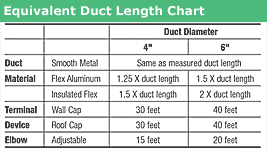The first step when sizing for a ventilating fan is to determine the application. Decide whether you are sizing for intermittent or continuous ventilation. If intermittent, determine which application i.e. bathroom, kitchen or other. Use the following industry recommendations to determine Air Changes per Hour (ACH) for your specific application.
Intermittent (spot) ventilation:
The Home Ventilating Institute (HVI) recommends the following Air Changes per Hour (ACH).
I. Bathrooms - 8 ACH
II. Kitchens - 15 ACH
III. Other Rooms - 6 ACH
Continuous (whole house) ventilation:
Many building codes have adopted the American Society of Heating Refrigerating and Air Conditioning Engineers (ASHRAE) Standard 62, as shown below.
- I. House or apartment - 0.35 ACH
Static Pressure and Duct Run:
A ventilating fan must overcome resistance when pushing air from the inlet, through the duct, to the outside of the building. This resistance is known as static pressure. The amount of static pressure depends on the duct length, type of duct, elbows and the roof jack or wall cap.
Equivalent Duct Length (EDL):
 Static pressure in a typical duct run is caused by the type of duct material, elbows, exterior wall cap, etc. The table shown illustrates the standard values for duct components. The EDL chart allows you to calculate the equivalent straight duct length in order to overcome static pressure caused by each component in a duct run. The EDL helps assure the fan performs as expected under the airflow resistance caused by the components listed in this chart.
Static pressure in a typical duct run is caused by the type of duct material, elbows, exterior wall cap, etc. The table shown illustrates the standard values for duct components. The EDL chart allows you to calculate the equivalent straight duct length in order to overcome static pressure caused by each component in a duct run. The EDL helps assure the fan performs as expected under the airflow resistance caused by the components listed in this chart. A ventilating fan's performance is plotted on a graph called a performance curve. The performance curve shows airflow in cubic feet per minute (CFM) along the horizontal axis and static pressure (resistance) along the vertical axis. The fan with a "Closed duct" has high static pressure and no airflow; and the fan with "No duct" has low static pressure and high airflow. In reality, an installed fan will be somewhere in between these two points.
Typical sizing: (Rule of Thumb)Range of square foot: 1 sq. ft per cfm up to 1.2 sq. ft per cfm max.
The following method can be used for sizing fans. The Sizing Chart Method follows industry standards and will give you similar outcomes. The Sizing Chart Method is easier.
Note: You should check with your local building inspector to confirm that these methods are accepted in your area.
Sizing Chart Method: Example: Sizing for an 8 ft x 12 ft x 8 ft ceiling bathroom using 12-foot long, 4 inch diameter aluminum flex duct, one elbow, one wall cap.
Step 1. Determine the ACH required for the given application using the HVI and ASHRAE standards above. • Bathroom – 8 ACH
Step 2. Calculate the Area to be ventilated in Square Feet.
2a. Assuming 8 foot ceiling: room length x width. • 8 ft x 12 ft = 96 sq ft.
2b. Guideline for cathedral ceilings:
i. 10 – 12 ft cathedral = length x width x 1.25
ii. 12 – 16 ft cathedral = length x width x 1.5
Step 3. Use the Equivalent Duct Length chart above to calculate the duct run.
3a. 12 ft flex aluminum duct x 1.25 = 15 feet EDL
3b. One elbow equals 15 feet EDL
3c. One roof jack equals 30 feet EDL
• (12 ft length x 1.25 alum. flex) + 15 ft elbow + 30 ft wall cap = 60 ft EDL
This is the equivalent duct length (or resistance) the fan must overcome to move air through the duct to the outside.

